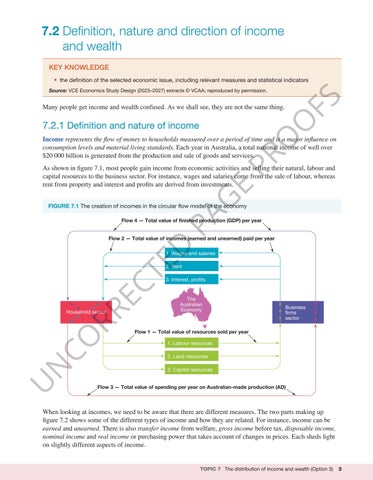“c07TheDistributionOfIncomeAndWealth_PrintPDF” — 2022/6/2 — 15:01 — page 3 — #3
7.2 Definition, nature and direction of income and wealth KEY KNOWLEDGE • the definition of the selected economic issue, including relevant measures and statistical indicators
FS
Source: VCE Economics Study Design (2023–2027) extracts © VCAA; reproduced by permission.
O
Many people get income and wealth confused. As we shall see, they are not the same thing.
O
7.2.1 Definition and nature of income
PR
Income represents the flow of money to households measured over a period of time and is a major influence on consumption levels and material living standards. Each year in Australia, a total national income of well over $20 000 billion is generated from the production and sale of goods and services.
G
E
As shown in figure 7.1, most people gain income from economic activities and selling their natural, labour and capital resources to the business sector. For instance, wages and salaries come from the sale of labour, whereas rent from property and interest and profits are derived from investments.
PA
FIGURE 7.1 The creation of incomes in the circular flow model of the economy Flow 4 — Total value of finished production (GDP) per year
D
Flow 2 — Total value of incomes (earned and unearned) paid per year
TE
1. Wages and salaries 2. Rent
CO RR EC
3. Interest, profits
Household sector
The Australian Economy
Business firms sector
U
N
Flow 1 — Total value of resources sold per year 1. Labour resources 2. Land resources 3. Capital resources
Flow 3 — Total value of spending per year on Australian-made production (AD)
When looking at incomes, we need to be aware that there are different measures. The two parts making up figure 7.2 shows some of the different types of income and how they are related. For instance, income can be earned and unearned. There is also transfer income from welfare, gross income before tax, disposable income, nominal income and real income or purchasing power that takes account of changes in prices. Each sheds light on slightly different aspects of income.
TOPIC 7 The distribution of income and wealth (Option 3)
3





















































